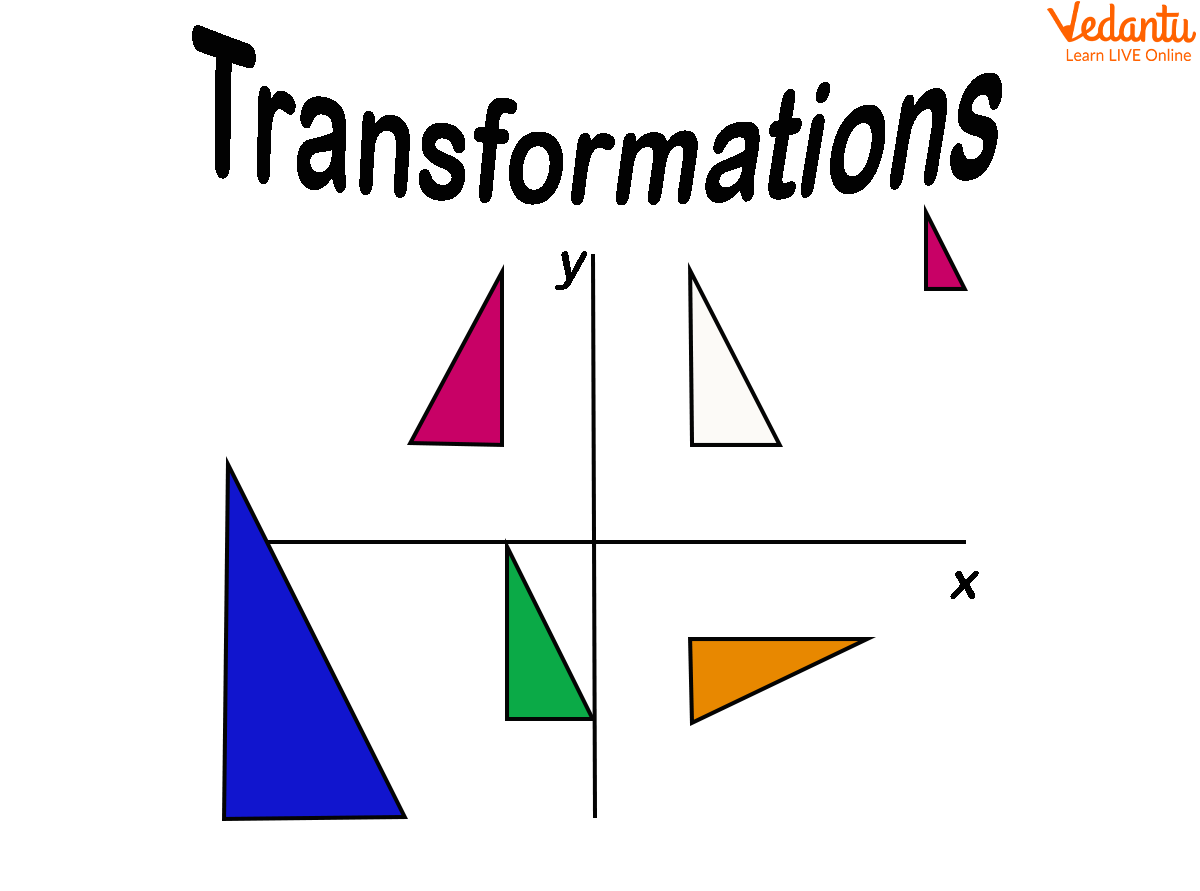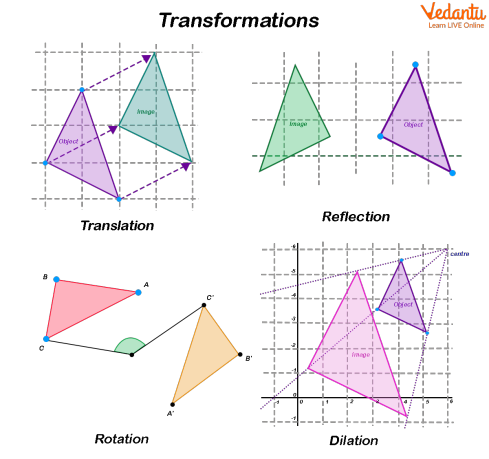




How Do Transformations Work in Geometry?
In normal words transformation means a mathematical function. You can say that a transformation is the invertible function from any set X to its own set X or any other set Y. For any term the transformation may simply indicate that the geometric aspect of this particular function is considered. Further these transformations are of many types. In layman's terms you can say that's means just taking a preimage and then transforming it or producing it into an actual image.
Thus when an object is transformed from its one form to another form then both the object and image can be congruent or they can be just similar.
When the shape of an object can easily be transformed to another shape just by using turns, flips or slides then both the shapes can be known as congruent while when one shape needs to be resized to form the another shape then we can refer to it as similar shapes.
This article provided to you by Vedantu will help to clear your doubts and queries related to the topic transformations. At Vedantu our main goal is to make the students proud of any topic they learn, so in order to be well aware of the topic, the students are provided with frequently asked questions at the end of this article in order to clear most of their queries regarding the topic Transformation.
In this article you are going to learn about this topic transformation in mathematics which is the base of your mathematics if higher classes. In this article the topics that you will come across are transformation, definition of transformation , categories of Transformation,types of transformation and finally the conclusion. Let's have a look at this article in order to get a better knowledge of the transformation topic.
In geometrical terms, when objects move in the coordinate plane, they go through transformations. In other terms, a set of coordinate points change into a different set of coordinates by the process of transformation. As in English, “transformation” means “to change,” in geometry, it refers to changes in the geometric properties of an object. There are different kinds of transformations that can occur; some of them do not change the size of the object while some of the transformations resize the original object. We will look at the different kinds of transformation in this article with examples.
What is Transformation in Maths?
According to Merriam - Webster dictionary, transformation means “an act, process, or instance of transforming or being transformed”. In maths, transformations are rotations, reflections, and translations of forms on a coordinate plane. Felix Klein proposed a new perspective on geometry known as transformational geometry in the nineteenth century. The majority of geometric proofs are dependent on object transformations. Transformations allow us to change any image in a coordinate plane.
The transformation is a function, f, that maps to itself, i.e. f: X → X. After the transformation, the pre-image X becomes the picture X. Any or a combination of operations such as translation, rotation, reflection, and dilation can be used in this transformation. Transformation is the act of moving a function in one direction, rotation is the act of spinning a function around a point, reflection is the function's mirror image, and dilation is the act of scaling a function. In mathematics, transformations describe the movement of two-dimensional figures around a coordinate plane.

Transformations in Maths
Categories of Transformation
A transformation can be broadly categorised into 2 different types:
Rigid or isometric Transformation – The transformation in which size of the pre-image is unchanged is called a rigid transformation. If you look at this transformation then you are not going to find any change in the form,that is the shape and size of the object.
Non-Rigid or non-isometric Transformation – A transformation that will change the size, but not the shape of the pre-image is called a non-rigid transformation. If you look at this transformation then you are not going to find any change in the form,that is the shape and size of the object.
Different Types of Transformations in Mathematics

Types of transformations
There are four types of transformations - translation, rotation, reflection, and dilation. Out of these, rotation, translation and reflection are rigid transformations. Rigid transformations keep the length and angle measurements, as well as the perimeter and area intact. The picture and the preimage are congruent. Dilation is non rigid transformation. Angle measure is the only thing that non-rigid transformations keep. The perimeter and side lengths are not equal, but they are in proportion. The picture and the preimage are remarkably similar.
Translation — A translation moves the figure away from its original coordinate plane position without changing its orientation.
Rotation — The image is the preimage rotated around a fixed point; "a turn."
Reflection — Consider cutting out a preimage, lifting it, and repositioning it face down. That's called a reflection or a flip. A reflection image is a reflection of the preimage.
Dilation — The image is a larger or smaller version of the preimage; "shrinking" or "enlarging." To dilate a polygon's preimage, duplicate its interior angles while increasing each side proportionally.
Rules of Transformation
Transformation is represented algebraically and graphically. Algebraic functions often include transformations. Rather than tabulating the coordinate values, we can use the formula of transformations in graphical functions to obtain the graph simply by transforming the basic or parent function and thus moving the graph around. Transformations assist us in visualising and learning algebraic equations.
Conclusion
When a geometric figure is moved around on a coordinate plane, then transformations happen. Transformations do not change the shape of an object but can change its position, size, or orientation. Transformation can be rigid or isometric, where the size of the image does not change, or they can be non-rigid or non-isometric when the size of the image changes due to the transformation. Transformations are mostly done on a coordinate plane, as it makes it easy to count and draw. A common and easiest way of performing transformation is by performing the required operation on the vertices of the preimage, and when you connect the dots, you will be able to get the final transformed image.
FAQs on Transformations in Geometry: Concepts, Types & Examples
1. What is a geometric transformation in simple terms?
A geometric transformation is a process that changes a shape's position, size, or orientation on a plane. The original shape is called the preimage, and the final shape after the transformation is called the image. Transformations are a fundamental way to describe how geometric figures relate to one another.
2. What are the four main types of transformations in geometry?
The four main types of geometric transformations are:
- Translation: This involves sliding a shape from one location to another without changing its size, shape, or orientation.
- Rotation: This involves turning a shape around a fixed point, known as the center of rotation.
- Reflection: This involves flipping a shape across a line, called the line of reflection, to create a mirror image.
- Dilation: This involves resizing a shape by making it larger or smaller, controlled by a scale factor.
3. What is the difference between rigid and non-rigid transformations?
The key difference lies in whether the shape's size is preserved. Rigid transformations (also called isometries) move a shape without changing its size or the angles within it. The image is always congruent to the preimage. Translation, rotation, and reflection are rigid transformations. In contrast, a non-rigid transformation changes the size of the shape. Dilation is the most common example of a non-rigid transformation.
4. What are some real-life examples of the four geometric transformations?
Transformations are visible all around us:
- Translation: An elevator moving straight up or down between floors.
- Rotation: The blades of a spinning fan or the hands of a clock turning around the center.
- Reflection: The image of a mountain in a still lake or your reflection in a mirror.
- Dilation: Using the zoom function on a camera to enlarge or shrink a view, or creating a miniature model of a building.
5. How do rigid transformations help in proving that two shapes are congruent?
Two geometric figures are defined as congruent if one can be mapped exactly onto the other using a sequence of one or more rigid transformations (translation, rotation, or reflection). Because these transformations preserve all distances and angles, they don't change the shape or size. Therefore, if you can move, turn, or flip one shape to perfectly align with another, they are proven to be congruent.
6. Why is dilation considered a non-rigid transformation?
Dilation is considered a non-rigid transformation because it alters the size of the preimage, which means the distances between its vertices change. A rigid transformation, by definition, must preserve all distances. Since dilation scales a figure by a scale factor (other than 1), the resulting image is similar to the preimage but not congruent, thus violating the core principle of rigidity.
7. What are the general coordinate rules for performing basic transformations on a 2D plane?
For a point (x, y) on a coordinate plane, the basic rules are:
- Translation: The point (x, y) moves to (x + a, y + b), where 'a' is the horizontal shift and 'b' is the vertical shift.
- Reflection across the x-axis: The point (x, y) moves to (x, -y).
- Reflection across the y-axis: The point (x, y) moves to (-x, y).
- Rotation of 90° counterclockwise about the origin: The point (x, y) moves to (-y, x).
- Dilation from the origin: The point (x, y) moves to (kx, ky), where 'k' is the scale factor.
8. What is the key difference between a reflection and a rotation?
The key difference is their effect on the shape's orientation. A rotation preserves orientation; if the vertices of a shape are labelled clockwise, their corresponding vertices in the image will also be in a clockwise sequence. A reflection, however, reverses the orientation. The image becomes a mirror version, so a clockwise orientation in the preimage becomes a counter-clockwise orientation in the image.
9. What is a glide reflection, and how does it combine two different transformations?
A glide reflection is a composite transformation that combines two basic rigid transformations: a reflection across a line and a translation parallel to that same line. Imagine creating footprints in the sand; each footprint is a translation and reflection of the previous one. It is a single, unique type of isometry, even though it is composed of two steps.
10. How are transformations used to create patterns like tessellations?
A tessellation is a repeating pattern of shapes that covers a surface without any gaps or overlaps. These patterns are created by taking a single base shape, called a tile, and repeatedly applying rigid transformations—specifically translation, rotation, and reflection—to place copies of the tile adjacent to each other. The famous artwork of M.C. Escher extensively uses these principles to create intricate tessellations of animals and figures.















